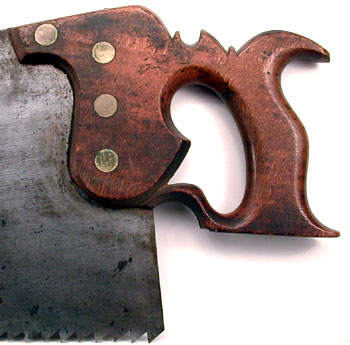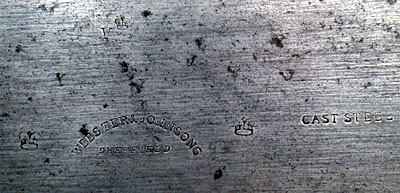Webster & Johnsong Rip Saw
 I'm not much for British saws,
but every once and a while, you see one that you can't live without.
Such is the case with this rip that was made by the Sheffield
firm of Webster & Johnsong. This massive 26" rip saw
has to be seen to be truly appreciated. A full 8" high at
the heel, and 3" at the toe, this saw has 3 1/2 ppi rip teeth
which get gradually finer as you go toward the toe, ending up
at 4 ppi. I do not know much about this firm, but I estimate the
saw from about 1820 based on the handle style, and other markings.
I'm not much for British saws,
but every once and a while, you see one that you can't live without.
Such is the case with this rip that was made by the Sheffield
firm of Webster & Johnsong. This massive 26" rip saw
has to be seen to be truly appreciated. A full 8" high at
the heel, and 3" at the toe, this saw has 3 1/2 ppi rip teeth
which get gradually finer as you go toward the toe, ending up
at 4 ppi. I do not know much about this firm, but I estimate the
saw from about 1820 based on the handle style, and other markings.
 The handle on this saw is made
of English Beech with four early split nut type brass screws.
If you examine the handle closely, you will soon see that it is
very different from others that you have seen on this site. First
off, the bottom of the handle is flat. This a characteristic of
the London Pattern, as it is called. Saws like this
are generally very early. Another thing you might notice is that
the handle is nearly perpendicular to the axis of the blade. This
is another characteristic of early saws. Finally, you will see
several embellishments on the top of the handle, and then a steep
rise. This is known as a drop front handle for obvious
reasons. If you were to take the handle off, you would see the
the steel ends at a right angle under the drop off. It wasn't
until much later did the plate under saws get relieved to allow
the handle to come up closer to the blade. Henry Disston's D8
was the first saw to use this feature which was known as a let
in handle.
The handle on this saw is made
of English Beech with four early split nut type brass screws.
If you examine the handle closely, you will soon see that it is
very different from others that you have seen on this site. First
off, the bottom of the handle is flat. This a characteristic of
the London Pattern, as it is called. Saws like this
are generally very early. Another thing you might notice is that
the handle is nearly perpendicular to the axis of the blade. This
is another characteristic of early saws. Finally, you will see
several embellishments on the top of the handle, and then a steep
rise. This is known as a drop front handle for obvious
reasons. If you were to take the handle off, you would see the
the steel ends at a right angle under the drop off. It wasn't
until much later did the plate under saws get relieved to allow
the handle to come up closer to the blade. Henry Disston's D8
was the first saw to use this feature which was known as a let
in handle.
 Finally, the blade is hand stamped
with the firm who made the saw. In addition, you will see three
crowns around the maker information. This is a trait of very early
British Saws. While I don't know the significance exactly, it
has to do with licensing by the crown.
Finally, the blade is hand stamped
with the firm who made the saw. In addition, you will see three
crowns around the maker information. This is a trait of very early
British Saws. While I don't know the significance exactly, it
has to do with licensing by the crown.
 I'm not much for British saws,
but every once and a while, you see one that you can't live without.
Such is the case with this rip that was made by the Sheffield
firm of Webster & Johnsong. This massive 26" rip saw
has to be seen to be truly appreciated. A full 8" high at
the heel, and 3" at the toe, this saw has 3 1/2 ppi rip teeth
which get gradually finer as you go toward the toe, ending up
at 4 ppi. I do not know much about this firm, but I estimate the
saw from about 1820 based on the handle style, and other markings.
I'm not much for British saws,
but every once and a while, you see one that you can't live without.
Such is the case with this rip that was made by the Sheffield
firm of Webster & Johnsong. This massive 26" rip saw
has to be seen to be truly appreciated. A full 8" high at
the heel, and 3" at the toe, this saw has 3 1/2 ppi rip teeth
which get gradually finer as you go toward the toe, ending up
at 4 ppi. I do not know much about this firm, but I estimate the
saw from about 1820 based on the handle style, and other markings.
 The handle on this saw is made
of English Beech with four early split nut type brass screws.
If you examine the handle closely, you will soon see that it is
very different from others that you have seen on this site. First
off, the bottom of the handle is flat. This a characteristic of
the London Pattern, as it is called. Saws like this
are generally very early. Another thing you might notice is that
the handle is nearly perpendicular to the axis of the blade. This
is another characteristic of early saws. Finally, you will see
several embellishments on the top of the handle, and then a steep
rise. This is known as a drop front handle for obvious
reasons. If you were to take the handle off, you would see the
the steel ends at a right angle under the drop off. It wasn't
until much later did the plate under saws get relieved to allow
the handle to come up closer to the blade. Henry Disston's D8
was the first saw to use this feature which was known as a let
in handle.
The handle on this saw is made
of English Beech with four early split nut type brass screws.
If you examine the handle closely, you will soon see that it is
very different from others that you have seen on this site. First
off, the bottom of the handle is flat. This a characteristic of
the London Pattern, as it is called. Saws like this
are generally very early. Another thing you might notice is that
the handle is nearly perpendicular to the axis of the blade. This
is another characteristic of early saws. Finally, you will see
several embellishments on the top of the handle, and then a steep
rise. This is known as a drop front handle for obvious
reasons. If you were to take the handle off, you would see the
the steel ends at a right angle under the drop off. It wasn't
until much later did the plate under saws get relieved to allow
the handle to come up closer to the blade. Henry Disston's D8
was the first saw to use this feature which was known as a let
in handle. Finally, the blade is hand stamped
with the firm who made the saw. In addition, you will see three
crowns around the maker information. This is a trait of very early
British Saws. While I don't know the significance exactly, it
has to do with licensing by the crown.
Finally, the blade is hand stamped
with the firm who made the saw. In addition, you will see three
crowns around the maker information. This is a trait of very early
British Saws. While I don't know the significance exactly, it
has to do with licensing by the crown.